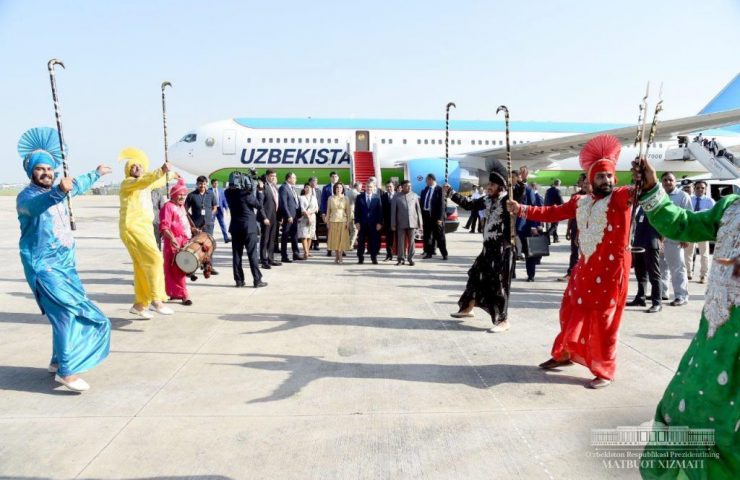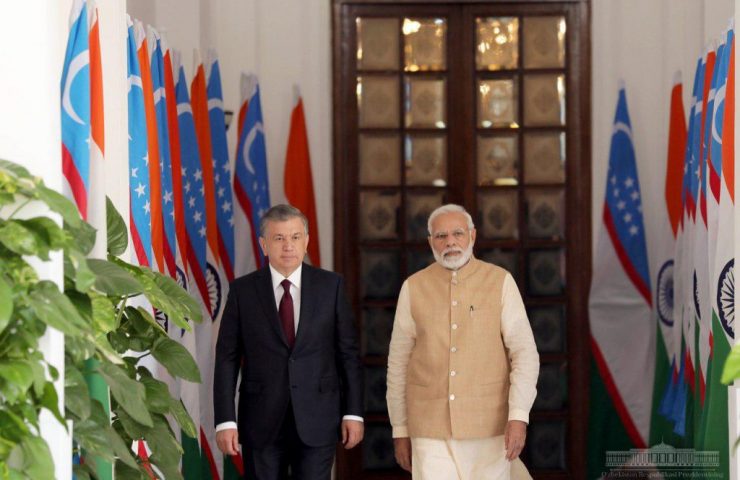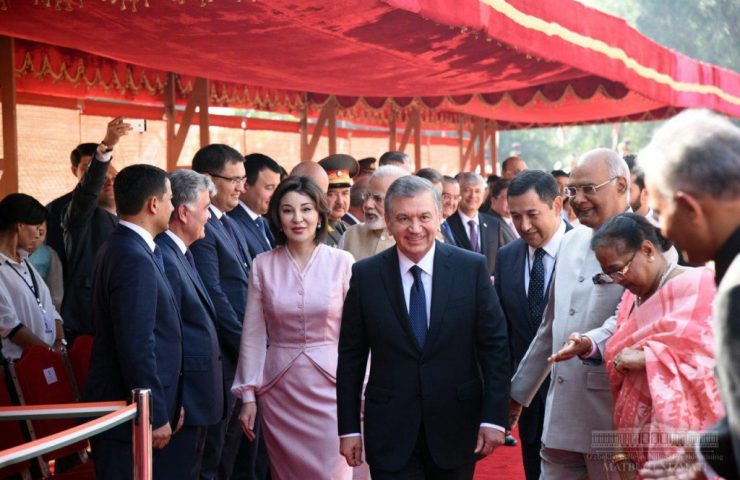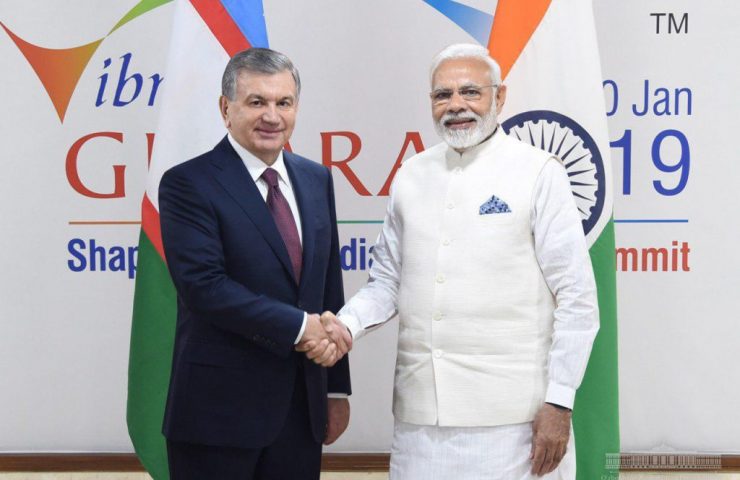Recently, India’s presence in Central Asia has become more active. The head of the department of the Center for Contemporary History of Uzbekistan under the Academy of Sciences of the Republic of Uzbekistan, professor, doctor of historical sciences Mirzokhid Rakhimov, spoke about how India is building relations with the countries of the region, in an interview for CABAR.asia.
Follow us on LinkedIn
In recent years, there has been a definite shift in relations between the Central Asian countries. The main impetus was the initiative of the new government of Uzbekistan to hold consultative meetings of the heads of state of the region. This contributed to the rapprochement of the Central Asian five, the development of a common, balanced position on topical issues of the regional agenda and the promotion of common interests in the world arena.
This circumstance makes Central Asia even more attractive to external players who are in a geopolitical race for the right to dominate their interests. In addition to Russia, China and the Western powers, India’s presence in the region has become increasingly noticeable in recent years.
The head of the department of the Center for Contemporary History of Uzbekistan under the Academy of Sciences of the Republic of Uzbekistan, professor, doctor of historical sciences Mirzokhid Rakhimov, spoke about the features of this process, in an interview for CABAR.asia.
CABAR.asia: What are India’s interests in Central Asia?

India has always been and remains a friendly country for Central Asia. We are connected by both historical and cultural ties and long-standing trade, economic, and political relations. The Great Silk Road, which in ancient times ran through the territory of Central Asia, led not only to China, but also to India. The Baburid dynasty – our ancestors who ruled India for many centuries – made an invaluable contribution to the development and prosperity of the country. In modern India, they remember this fact and have great respect for the homeland of the great Babur.
The closeness of general cultural, historical, and human factors was preserved in Soviet times as well. Due to this fact, our region played an important role in building trusting relations between the USSR and India. This is especially true for Uzbekistan – all official visits from Moscow to Delhi and back usually went through Tashkent. After the collapse of the Soviet Union, historical continuity helped us to establish bilateral relations with India already as an independent state. The same can be said about the rest of the region.
India’s presence in Central Asia is primarily due to trade and economic interests. The country works for the long term (which, in principle, is typical for the Asian giant), actively investing in its traditional areas – the textile industry, innovative medicine, pharmaceuticals, information technology. India is also supporting the construction of the Mazar-i-Sharif-Herat railway. This project is strategically important for Central Asia, especially Uzbekistan, which does not have direct access to seaports. The railway corridor, which runs through the territory of Afghanistan, literally through Iran, will open India’s doors to Central Asia, providing an opportunity for all interested parties to gain access to the markets of neighboring countries and regions.
Expanding trade and economic contacts in the North-South direction, India is also striving to strengthen political dialogue with its most significant partners. This is not only about Afghanistan, Iran, Central Asian countries, but also Russia and Eastern Europe.
In this context, it should be borne in mind that India is the second country in the world in terms of population and the sixth in terms of GDP. With such impressive indicators in the foreseeable future, India may well become the fourth center of power. Although even now it has a special clout in the international political arena. India is called the world’s largest democracy. Thus, cooperation with India, with the correct placement of accents, can give the necessary impetus for the further development of the Central Asian countries.
What can Central Asian countries learn from India today?
I think, many things can be learned. First, India has very good traditions of political culture. The country is making confident steps towards democracy, which deserves special attention of the world community. The second thing to focus on is India’s economic growth and investment potential. As you know, India is recognized as the largest trading and industrial power of the Asian continent, as well as a world giant in the field of information technology, pharmaceuticals, and the textile industry. The country is the main exporter of IT services, software to the global market and is the leader in the number of technology startups. The country actively supports various training programs for the preparation of IT specialists. Due to this fact, hundreds of young people from Central Asia have the opportunity to study in the leading educational centers of India every year.
The country’s achievements in the IT industry deserve special attention. Today Indian programmers are in demand all over the world. This is the result of a fruitful human capital development policy. Despite the huge population surplus, the proportion of skilled workers in India is increasing. Most of them work in the United States, Europe, and the Arab East. However, there are those who, without leaving their homes, cooperate with the largest companies in the world – Microsoft, Facebook, Google, and others. In addition, Indian specialists hold positions of responsibility in foreign countries and international organizations. This is a vivid example of how India was able to successfully integrate into the world economic system, including labor relations. I think the countries of Central Asia could well adopt the experience of India in this direction.
There are other industries in which India has succeeded, such as pharmaceuticals. The Indian pharmaceutical industry is one of the most recognized in the world. Its products are in great demand due to their availability and favorable price characteristics. It should be noted that about 30 percent of medical products imported into Central Asia come from India and this is not the limit. I think that with the development of trade and economic contacts, we will have the opportunity not only to purchase Indian medicines, but also to establish joint production on a regional scale.
I would also like to mention the Indian higher education system. It is quite developed. There are many interesting and useful educational programs. The country is actively working to stimulate representatives of the lower social strata (the so-called “positive discrimination”). For example, the state provides them with benefits for admission to a university, and in some cases people from poor families are enrolled in studies without exams. By the way, a similar practice has been introduced in Uzbekistan. Since last year, a program for stimulating women has been launched in the country, within the framework of which separate budgetary places are allocated in higher educational institutions for girls from low-income families.
In general, the educational experience of India, especially in the training of IT specialists and medical workers, is indicative for our countries. From this point of view, it is advisable to develop partnerships in this area, to implement joint programs with Indian universities. Last year, two Indian universities were opened in Uzbekistan – Amity (in Tashkent) and Sharda (in Andijan). Recently, the construction of a branch of the Indian Institute of Technology Sambram in Jizak region was launched. I hope that such fruitful work will continue in the future.
India began to actively cooperate with Uzbekistan. Judging by the dynamics of relations, does India consider Uzbekistan as a key partner in the region? Why do you think it is so?
Earlier I have noted that India and Uzbekistan have a centuries-old history of cooperation. It dates back to the period of the Baburid dynasty in India. A warm attitude towards the Uzbek people, of course, has a positive effect on the relationship between the two countries. It should be noted that the first president of Uzbekistan, Islam Karimov, made his first foreign visit to India in August 1991. Our ties with India at the political level have never been interrupted. However, with the coming to power of Shavkat Mirziyoyev, she received a new impetus. Over the past few years, Uzbek-Indian relations have begun to acquire a strategic character, which speaks volumes.
Photo: president.uzAnother important fact. In terms of population, Uzbekistan is the largest state in Central Asia, and in terms of geographic location, it is also central. In this regard, India, which is very profitable to use the transit potential of our region, perceives Uzbekistan as a connecting transport and communication link, allowing it to get closer to other countries of Central Asia.
However, our neighbors also have long-term contacts with India. For example, the leadership of Kazakhstan signed a number of agreements, including investment agreements related to the extraction of uranium and other mineral recourses.
I believe that today India has closer cooperation with Uzbekistan and Kazakhstan, and also certain relationships with Kyrgyzstan, Tajikistan, and Turkmenistan. This is due to the potential of each of the countries.
India is interested in building a trans-Afghan railway corridor. What is the significance of this project for Central Asia?
The Mazar-i-Sharif – Herat railway line is one of the shortest land routes providing access to the Indian Ocean by the Central Asian countries. Therefore, all countries in the region will benefit from its construction since the new transport artery and logistic junctions will serve to further develop their transit potential. Moreover, there will be an incentive for an early settlement of the Afghan conflict by joint efforts. After all, the main railway will cross the territory of neighboring Afghanistan, which undoubtedly contributes to the involvement of the brotherly state in the system of interregional trade.
The Trans-Afghan Railway leads to the Iranian seaport of Chabahar. It is the largest transshipment base for the transportation of goods through India to other continents of the world. In this respect, the Central Asian countries benefit enormously as can make money on the transit of goods, both imported and exported. In addition, we get the opportunity to enter the markets of India, Afghanistan, Iran, and other countries by the shortest route and at no extra cost.
Interestingly, Uzbekistan also supports another similar project initiated by Pakistan. In early February 2021, the parties, including Afghanistan, signed a document on the construction of the Mazar-i-Sharif – Kabul – Peshawar railway. Experts are ambiguous in their assessments, and there are even opinions that the Pakistani direction should not be a priority for Uzbekistan and that the construction of a trans-Afghan way with access to the Chabahar port is much more important. What do you think about this fact?
I do not share that interpretation of events. It is beneficial for Uzbekistan and other Central Asian republics to develop different directions and diversify communications. For example, the Afghan Iranian transport corridor is important from the point of view of taming the path to the Indian Ocean. But the Afghan-Pakistani direction is also quite interesting, since many are ready to invest in this project, including China, which is directly interested in building a railway to Peshawar. In addition, Pakistan is a key strategic partner of the Middle Kingdom in South Asia.
Participation in various international transport and communication projects has become an important part of the economic policy of Uzbekistan. After all, one should not forget that Pakistan is a fairly large market and needs a certain amount of energy resources. In turn, Pakistan is also a fairly developed state. But there are nuances, first of all, it concerns security issues. Therefore, the countries of Central Asia should not ignore any of the external partners, but, on the contrary, rapidly establish constructive cooperation with every possible partner.
About external players. How is India’s presence in Central Asia perceived by world powers with geopolitical interests in the region?
In my opinion, most of the major players with an interest in Central Asia – Russia, the European Union, the United States – support this desire. The only exception is China, which is more wary of India. The same can be said for Pakistan. Since India perceives Pakistani-Chinese relations as a challenge for India, while Pakistan regards the expansion of Iran’s partnership with India as a challenge to the interests of Pakistan and China. Despite this, I think the Celestial Empire will continue to develop trade and economic cooperation with all countries. China is interested in expanding cooperation between Central and South Asian countries, because it will ultimately bring benefits. Of course, Pakistan is rather wary of this process and will not particularly welcome India’s presence in Central Asia.
On the other hand, the trans-Afghan-Pakistani transport corridor cannot be built without the participation of Pakistan itself. Indeed, even for India, especially for its northern part, the most optimal option is to build roads and TAPI to Central Asia through Afghanistan and Pakistan since it takes a very long time to bypass Pakistan through the territory of Iran.
How do you see the development of relations between the Central Asian countries and India in the long-term perspective?
The Indian direction will continue to remain traditional for both Uzbekistan and our neighbors. If we talk about trade and economic ties, the situation here is much more complicated. The share of Indian investment in the region as a whole is still very modest. For example, India does not even make it into the top ten countries of leaders among the trade partners of Uzbekistan, although the potential of both countries is incredibly large. However, business goes where it is more convenient and profitable to work. I think that as transport and communication issues are resolved in the future, we can count on an increase in the volume of Indian capital in the national economies of Central Asia.
This material has been prepared as part of the Giving Voice, Driving Change – from the Borderland to the Steppes Project. The opinions expressed in the article do not reflect the position of the editorial board or the donor.








